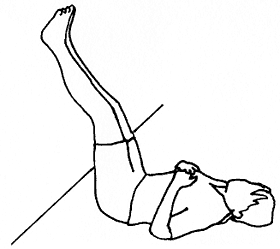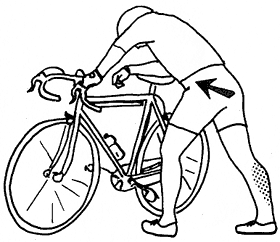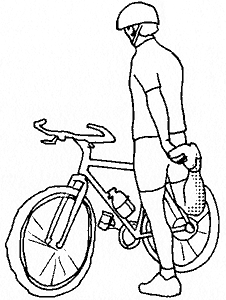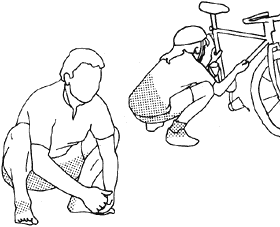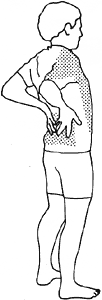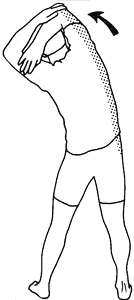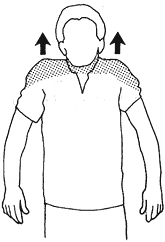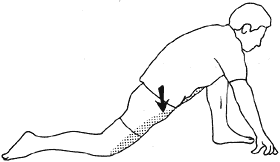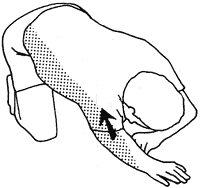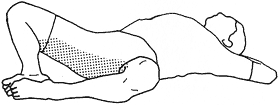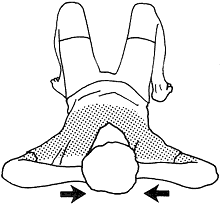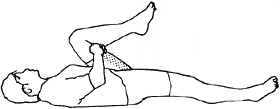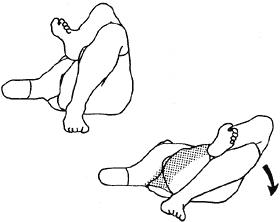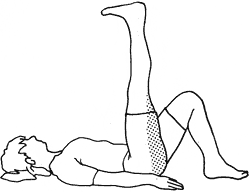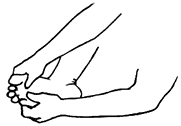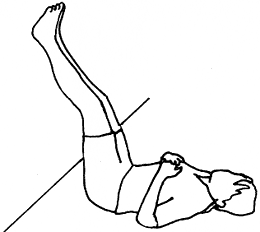|
Cycling Stretches
After Riding |
|
|
Note: If you've had any recent surgery, muscle or joint problems, please consult your personal health-care professional before starting a stretching or exercise program. How to stretch: Stretch slowly without bouncing. Stretch to where you feel a slight, easy stretch. Hold this feeling for 5 to 30 seconds. As you hold this stretch, the feeling of tension should diminish. If it doesn't, just ease off slightly into a more comfortable stretch. The easy stretch reduces tension and readies the tissues for the developmental stretch. | |
| 1. To stretch your calf, stand a little ways from a solid support and lean on it with your forearm. Bend one leg and place your foot on the ground in front of you leaving the other leg straight, behind you. Slowly move your hips forward until you feel a stretch in the calf of your straight leg. Be sure to keep the heel of the foot on the straight leg on the ground and your toes pointed straight ahead. Hold an easy stretch for 30 seconds. Do not bounce. Stretch both legs. |
|
| 2. Opposite hand to opposite foot - quads and knee stretch: With the left hand, grab the top of the right foot (from the inside of the foot) and gently pull, moving the heel towards your buttocks. The knee bends at a natural angle in this position and creates a good stretch in the knee and quads. This is especially good to do if you have had trouble or feel pain stretching in the hurdle stretch position leaning back, or when pulling the right heel to the butt with the right (same) hand. Pulling opposite hand to opposite foot does not create any adverse angles in the knee and is especially good in knee rehab and with problem knees. Hold for 30 seconds. Do both legs. |
|
| 3. With your feet shoulder-width apart and pointed out to about a 15-degree angle, heels on the ground, bend your knees and squat down. If you have trouble staying in this position, hold onto something for support. This is a great stretch for your ankles, Achilles tendons, groin, lower back and hips. Hold the stretch for 30 seconds. Be careful if you have had any knee problems. If you feel pain, discontinue this stretch. |
|
| 4. Standing with the knees slightly bent, place your palms on the lower back just above the hips, fingers pointing downward. Gently push your palms forward to create an extension in the lower back. Hold comfortable pressure for 10 to 12 seconds. Repeat twice. Use this stretch after sitting for an extended period of time. |
|
| 5. With arms overhead, hold the elbow of one arm with the hand of the other arm. Keeping the knees slightly bent (1 inch), gently pull your elbow behind your head as you bend from your hips to the side. Hold an easy stretch for 10 seconds. Do both sides. Keep your knees slightly bent for better balance. |
|
| 6. Shoulder shrug: Raise the top of your shoulders toward your ears until you feel slight tension in your neck and shoulders. Hold this feeling of tension for 3 to 5 seconds, then relax your shoulders downward into their normal position. Do this 2 to 3 times. This is a good stretch to use at the first signs of tightness or tension in the shoulder and neck areas. |
|
| 7. As shown, move one leg forward until the knee of the forward leg is directly over the ankle. Your other knee should be resting on the floor. Now, without changing the position of the knee on the floor or the forward foot, lower the front of your hip downward to create an easy stretch. This stretch should be felt in front of the hip and possibly in your hamstrings and groin. This will help relieve tension in the lower back. Hold the stretch for 30 seconds. Do both legs. |
|
| 8. With legs bent under you, reach forward with one arm and grab the end of the mat, carpet, or anything you can hold onto. If you can't grab onto something, just pull back with your arm straight while pressing down slightly. Do likewise, pulling on the end of the mat. Hold the stretch for 20 seconds. Stretch each side. Don't strain. You should feel the stretch in your shoulders, arms, sides, upper back or even in your lower back. |
|
| 9. Relax with your knees bent and the soles of your feet together. This comfortable position will stretch your groin. Hold this stretch for 60 seconds. |
|
| 10. Interlace your fingers behind your head and rest your arms on the mat. Using the power of your arms, slowly bring your head, neck, and shoulders forward until you feel a slight stretch. Hold an easy stretch for 5 seconds. Repeat three times. Do not overstretch. | 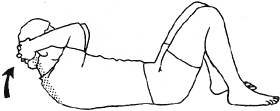 |
| 11. Shoulder blade pinch: From the bent-knee position, pull your shoulder blades together to create tension in the upper back area. (As you do this your chest should move upward.) Hold this controlled tension for 4 to 5 seconds, then relax and gently pull your head forward as shown in stretch 10. This releases tension and allows the neck to be stretched effectively. |
|
| 12. Next. straighten both legs and relax. then pull your left leg toward your chest. For this stretch keep the back of your head on the floor, if possible, but don't strain. Hold an easy stretch for 30 seconds. Repeat, pulling your right leg toward your chest. |
|
| 13. From a bent-knee position, interlace your fingers behind your head and lift the left leg over the right leg. From here, use your left leg to pull your right leg toward the floor until you feel a stretch along the side of your hip and lower back. Stretch and relax. Keep the upper back, shoulders, and elbows flat on the floor. The idea is not to touch the floor with your right knee, but to stretch within your limits. Hold for 30 seconds. Repeat the stretch for the other side. |
|
| 14. Straighten out your arms and legs. Point your fingers and toes as you stretch as far as you can. Stretch and then relax. This is a good stretch for the entire body. Hold for 5 seconds. |
|
| 15. Lie on your back, lift your leg up toward a 90-degree angle at the thigh joint. Keep the low back flat against the floor during the stretch. Hold the stretch for 15 to 20 seconds. Do both legs. |
|
| 16. With your thumbs, massage up and down the longitudinal arch of your foot. Use circular motions with a good amount of pressure to loosen tissues. Do both feet. Always massage your feet for 2 to 3 minutes before and after activity or after sitting or standing for long periods of time. This will reduce unwanted tension and keep the feet and legs feeling good. |
|
| 17. Elevate your feet. It's great for circulation and revitalization of tired legs and mind. Your lower back should be flat and not arched or off the floor. Do not elevate your feet for too long in the beginning: gradually increase the time (one to five minutes, or longer). |
|
|
CYCLING STRETCHES c1999 by Bob Anderson, illustrated by Jean Anderson, Stretching, Inc., has been reprinted by permission. For a free catalog of Stretching Inc. publications/products, visit www.stretching.com or call 800.333.1307, Box 767, Palmer Lake, CO 80133. CYCLING STRETCHES is available as a laminated 8 1/2- x 11-inch sheet, 22 1/2- x 34-inch poster, laminated, paper, or paper/folded, a 4- x 4 1/2-inch booklet and as a routine included in their book, STRETCHING. | |
 Skip to main content
Skip to main content
